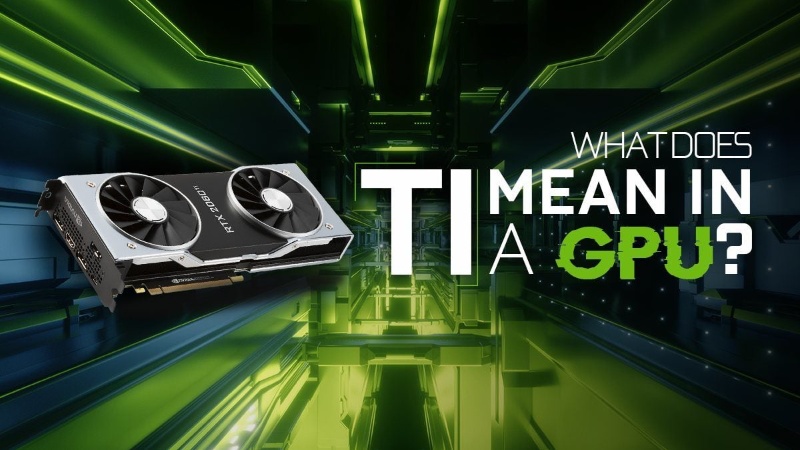1. Introduction
If you’ve ever shopped for GPUs, you’ve probably stumbled over confusing suffixes: “Ti,” “Super,” “XT”—what do they all mean? For AI enterprises, this confusion isn’t just a minor annoyance. When you’re investing in hardware to train large language models (LLMs) or power real-time inference, choosing the right GPU can mean the difference between smooth deployment and costly delays.
Among these labels, “Ti” stands out as a frequent source of questions. Is it just a marketing trick? Or does it signal something meaningful for your AI workloads? The answer matters because Ti-grade GPUs often promise the extra power needed for heavy tasks: training complex LLMs, handling multi-user inference, or running resource-heavy AI applications. But with that power comes higher costs—and a bigger risk of wasting resources if you don’t manage them well.
That’s where tools like WhaleFlux come in. WhaleFlux is an intelligent GPU resource management tool built specifically for AI enterprises. It helps optimize how you use high-performance GPUs (including Ti-grade models), reducing cloud costs while speeding up LLM deployment. In this guide, we’ll break down what “Ti” really means, why it matters for AI work, and how WhaleFlux ensures you get the most out of these powerful tools.
2. What Does “Ti” Actually Mean in GPUs? Origin & Core Definition
Let’s start with the basics: “Ti” is short for “Titanium.” You might know titanium as a strong, lightweight metal—think aerospace parts or high-end sports gear. NVIDIA, the company behind most GPUs used in AI, borrowed this name to send a clear message: Ti models are the “stronger, more durable” versions of their base GPUs.
This label isn’t new. It first appeared in the early 2000s with GPUs like the GeForce 2 Ti, where “Ti” was a prefix (not a suffix) signaling top-tier performance. Back then, it was a way to set premium models apart from entry-level options. Over time, it shifted to a suffix—think RTX 3080 Ti or RTX 4090 Ti—and became a standard marker for upgraded versions of existing GPUs.
Crucially, “Ti” isn’t just a fancy name. Unlike some other suffixes that might mean minor tweaks (like a small speed boost), Ti models almost always come with real, tangible upgrades. They’re designed to be workhorses—perfect for tasks that push GPUs to their limits, like training LLMs or processing large datasets.
3. How “Ti” Translates to Real-World GPU Performance (For AI Workloads)
For AI enterprises, the value of a Ti GPU lies in its specs. Let’s break down the key upgrades that make Ti models stand out—and why they matter for your AI projects.
More CUDA Cores: Power for Parallel Processing
CUDA cores are like the “workers” inside a GPU, handling the math and calculations needed for AI tasks. The more CUDA cores a GPU has, the more it can process at once—critical for training LLMs, which require billions of calculations.
Take the RTX 4080 and RTX 4080 Ti as an example. The base RTX 4080 has around 7,680 CUDA cores, while the Ti version jumps to roughly 10,240. That’s a 33% increase—meaning the Ti model can train a model like GPT-3.5 or process inference requests much faster. For AI teams racing to deploy new features, those extra cores can cut days off a project timeline.
Larger VRAM: Room for Big Models
VRAM (video random access memory) is where a GPU stores data it’s actively using—like parts of an LLM or batches of input data. For large models, more VRAM means the GPU can handle bigger chunks of work without slowing down.
Ti models often come with more VRAM than their base counterparts. The RTX 3080, for instance, has 10GB of GDDR6X VRAM, while the RTX 3080 Ti bumps that up to 12GB. Why does this matter? LLMs like Llama 2 or Mistral 7B have massive model checkpoints—sometimes 10GB or more. A Ti GPU with extra VRAM can load these models entirely into memory, avoiding slowdowns from “swapping” data in and out. This makes for smoother, faster inference, even with multiple users.
Higher Boost Clocks: Speed for Real-Time Tasks
Boost clock is the maximum speed at which a GPU can run, measured in gigahertz (GHz). A higher boost clock means faster processing for time-sensitive tasks—like real-time LLM inference, where users expect instant responses.
Ti models often have higher boost clocks than non-Ti versions. For example, a base GPU might hit 2.2GHz, while its Ti counterpart reaches 2.6GHz. That 0.4GHz difference might sound small, but in practice, it reduces latency—the delay between a user’s query and the model’s response. For AI chatbots or customer service tools, this can mean the difference between a seamless experience and a frustrating wait.
For AI enterprises, these upgrades add up: Ti GPUs mean faster training, smoother deployment, and better performance for end users. But there’s a catch—all this power comes with a price tag.
4. The AI Enterprise Challenge: Maximizing Ti-Grade GPUs (Without Wasting Money)
Ti GPUs are powerful, but they’re also expensive. A single high-end Ti GPU or its enterprise equivalent (like NVIDIA’s H100 or A100) can cost thousands of dollars to buy, or hundreds per month to rent. And when you scale up to multi-GPU clusters—necessary for training large models—those costs multiply quickly.
The problem? Many AI teams struggle to get their money’s worth. Let’s look at the biggest pain points:
High Costs, Wasted Capacity
Even a 20% waste in GPU usage can cost an enterprise tens of thousands of dollars per year. For example, if you’re paying to rent a Ti GPU cluster but only using 70% of its capacity because workloads are unevenly distributed, you’re throwing money away. Over time, these inefficiencies eat into your budget—money that could go toward improving your AI models.
Cluster Inefficiency
Most AI teams use multi-GPU clusters to handle large workloads. But without smart management, these clusters can become unbalanced: one Ti GPU might be overloaded, slowing down tasks, while another sits idle. This not only wastes resources but also creates bottlenecks. A model that should train in 5 days might take a week because the cluster isn’t using all its GPUs effectively.
Deployment Delays
Poor resource management can also slow down LLM deployment. If your team is waiting for a busy Ti GPU to free up before launching a new model, you’re losing time to competitors. The whole point of investing in Ti GPUs is to move faster—but without the right tools, you might end up moving slower.
These challenges create a “performance vs. efficiency” gap. Ti GPUs deliver the performance, but you need a way to ensure that performance translates to real value. That’s exactly what WhaleFlux is designed to fix.
5. WhaleFlux: Smart GPU Resource Management for Ti & Premium AI Hardware
WhaleFlux is more than just a tool—it’s a solution for making the most of your high-performance GPUs, whether they’re Ti models or enterprise workhorses like the H100 or A100. Let’s see how it addresses the challenges AI teams face.
5.1 WhaleFlux’s Supported GPU Lineup (Ti-Equivalent Powerhouses)
WhaleFlux is optimized for the GPUs that AI enterprises rely on most. Its lineup includes:
- NVIDIA H100 and H200: The latest enterprise GPUs, built for large-scale AI training and inference.
- NVIDIA A100: A proven workhorse for LLM training and multi-GPU clusters.
- NVIDIA RTX 4090: A popular choice for mid-scale AI projects, offering Ti-grade performance for smaller teams.
Whether you’re using Ti models or these enterprise equivalents, WhaleFlux works seamlessly to manage your resources. It’s designed to understand the unique strengths of each GPU—from the H100’s massive VRAM to the RTX 4090’s speed—and put them to their best use.
5.2 How WhaleFlux Solves AI Enterprises’ Ti-GPU Pain Points
WhaleFlux’s core strength is its ability to turn powerful GPUs into efficient ones. Here’s how it does it:
Optimize Cluster Utilization
WhaleFlux uses intelligent scheduling to distribute your AI workloads across all your GPUs—no more overloaded or idle hardware. For example, if you’re training a model on a cluster of RTX 4090s, WhaleFlux will split the work evenly, ensuring each GPU is used to its full potential. Many teams see their GPU utilization jump from 60% to 90% or higher—meaning you get more value from every dollar spent.
Cut Cloud Costs
By reducing waste, WhaleFlux directly lowers your GPU expenses. If you’re renting a cluster, better utilization means you might not need to add as many GPUs to handle peak workloads. If you own your hardware, you’ll extend its lifespan by using it efficiently. Either way, the savings add up—often 30% or more for teams with large clusters.
Speed Up LLM Deployment
WhaleFlux automates resource allocation, so your team spends less time managing GPUs and more time building models. When you’re ready to deploy a new LLM, WhaleFlux finds the best available GPU (or combination of GPUs) for the job, eliminating delays. No more waiting for a busy Ti GPU—your model goes live faster, keeping you ahead of the competition.
5.3 Flexible Access: Buy or Rent (No Hourly Leases)
WhaleFlux understands that AI projects have different timelines. That’s why it offers flexible access to its supported GPUs:
- Buy: Perfect for long-term projects or teams with steady workloads. Own your hardware and use WhaleFlux to maximize its value over time.
- Rent: Ideal for short-term needs, like a 3-month LLM training sprint. WhaleFlux offers rentals starting at one month—no hourly fees, so you avoid surprise costs.
This flexibility means you can match your GPU resources to your project, without overcommitting or underpreparing.
6. Real-World Example: WhaleFlux + Ti-Grade GPUs in Action
Let’s look at how WhaleFlux works for a typical AI startup. Imagine a team of 10 engineers building a customer support LLM. They use a cluster of 8 GPUs: 4 RTX 4090s (for their Ti-grade performance) and 4 A100s (for heavy training).
Before using WhaleFlux, the team struggled with inefficiency. Their RTX 4090s were often overloaded during peak inference hours, while the A100s sat idle overnight. Training cycles took longer than expected, and they were spending $15,000 per month on GPU rentals—with 30% of that wasted on unused capacity.
After switching to WhaleFlux, things changed:
- WhaleFlux balanced workloads, ensuring the RTX 4090s handled inference during the day and the A100s took over training at night.
- GPU utilization jumped from 65% to 92%, cutting their monthly costs to $9,750—a 35% savings.
- Training time for their LLM dropped by 20% (from 10 days to 8 days) because the cluster was used efficiently.
- Deploying updates to their model became faster, too—WhaleFlux automatically allocated resources, so launches happened in hours instead of days.
For this team, WhaleFlux turned their high-performance GPUs into a competitive advantage—without breaking the bank.
Conclusion
“Ti” in GPUs stands for “Titanium”—a label that promises stronger, faster performance thanks to more CUDA cores, larger VRAM, and higher boost clocks. For AI enterprises, these upgrades are game-changers, enabling faster training, smoother LLM deployment, and better user experiences.
But Ti-grade performance only matters if you can use it efficiently. Wasting even a fraction of a high-end GPU’s capacity costs money and slows down your work. That’s where WhaleFlux comes in. It optimizes your GPU clusters, cuts costs, and speeds up deployment—turning raw power into real results.
WhaleFlux isn’t just a resource manager. It’s a way to make sure your investment in premium GPUs pays off—whether you’re using Ti models, H100s, A100s, or RTX 4090s. With WhaleFlux, you get the performance you need, without the waste you don’t.

